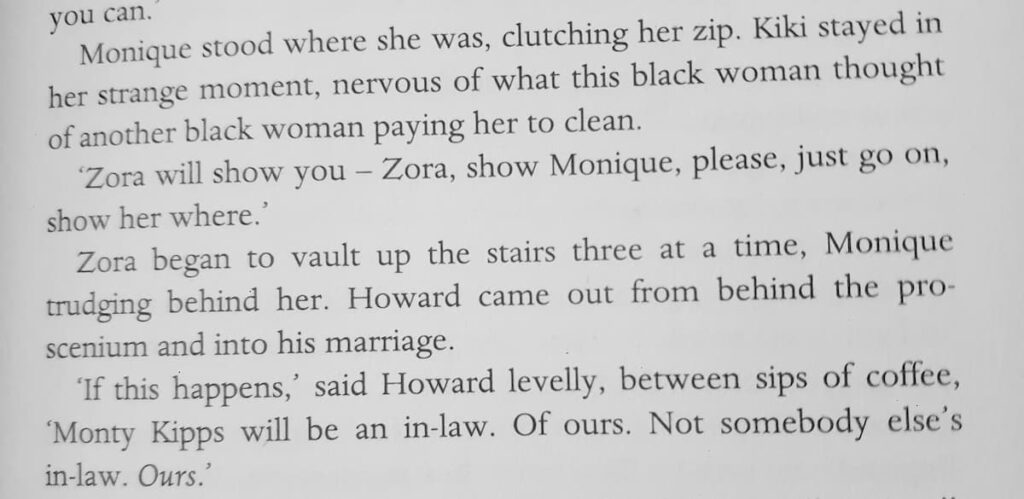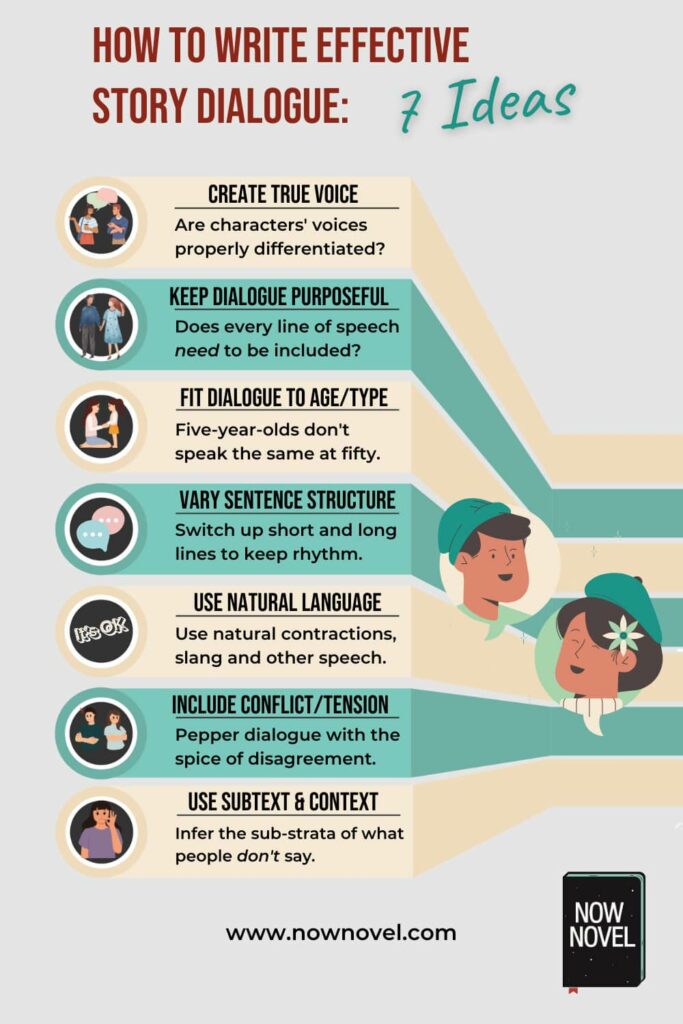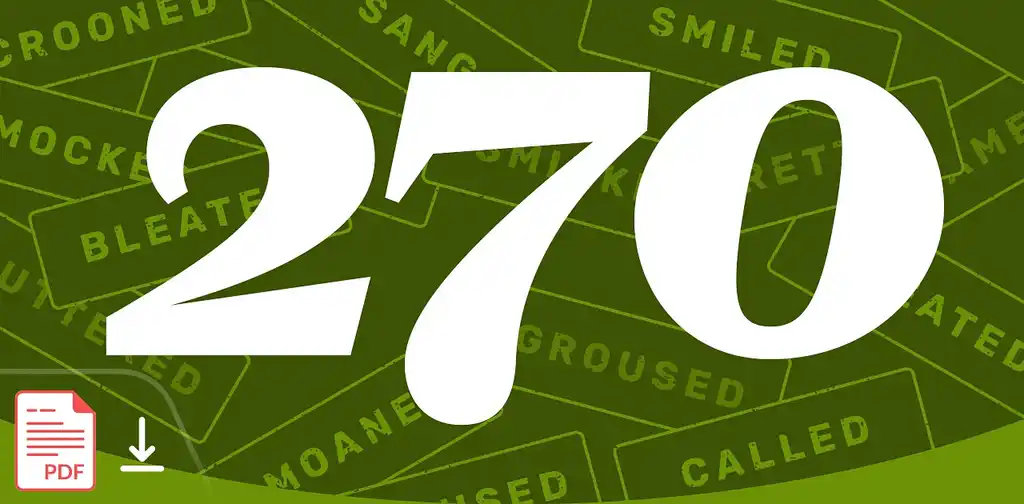What is dialogue? Key terms Why dialogue matters How to format dialogue Effective vs weak dialogue Dialogue devices Dialogue examples
This guide to writing dialogue is all about using speech and conversation in storytelling to make your characters' voices drive plot, tension and drama. Use the links to jump to the dialogue-writing topic you want to learn more about right now.
What is dialogue? Key terms
Dialogue in writing is conversation between two or more people/animated voices (animated voices because it could be speech between a person and an inanimate object they personify, for example, an imaginary or supernatural voice, and so forth).
Dialogue can be compared to:
- A tennis or fencing match: Speakers may spar, score points, volley arguments or statements (and rebuttals to them) back and forth
- A dance: One speaker says one line, the other replies, and sometimes one person may lead, at other times, the other leads
- Pieces in a puzzle coming together: What different characters say may build up a gradual picture, for example an idea of the persona of a character who has not yet appeared in a story scene but has been spoken about by others
- Music: sometimes there is harmony (working together), other times discord (strife, heated conversation or disagreement)
Key terms in writing dialogue
There are several terms in dialogue worth knowing as they crop up often in discussing this element of writing craft:
Active listening: Dialogue is (usually) responsive
When somebody is engaged in 'active listening', they aren't just waiting for their turn to speak. In a true conversation, people hear one another, respond.
There may be instances where your dialogue's subtext or context (more on these below) calls for characters not to actively listen to one another, of course. There may be cause for them to interrupt, speak over, speak at cross purposes.
In these cases, it should be contextually or otherwise clear why characters aren't properly responding to each other's speech (the dialogue should not read or sound like random non sequiturs, each person's utterances totally disconnected for no clear reason).
Context for dialogue
Effective dialogue involves its context. For example, in a frenzied car chase, the squeal of tires may drown out the exchange here or there. Speech and action in this context may reflect rapid decision-making, keeping pace.
In the middle of a bank heist, people may be curt, decisive (of course, inept thieves could wax lyrical and by talking too much make rookie mistakes).
Either way, context will inform how readers make sense of your dialogue, and helps to fill dialogue with tone and mood. Nobody whispers to each other standing next to Niagara falls (if they want to be heard).
Subtext and dialogue
Subtext in dialogue is the underlying meaning, motivation or feeling behind the words characters speak.
For example, a boss starts a casual conversation with a new employee but the subtext is that they're having regrets at hiring the person and trying to come to a decision on whether to terminate in the trial period. The subtext will inform what language they will use (and this language would be different to someone ecstatic with their employee's performance).
Subtext adds depth and complexity to dialogue, strata of the said and unsaid.
Purpose in dialogue
Why is the information you are writing in a scene given as dialogue? Knowing the purpose of dialogue (and writing dialogue that feels purpose-driven) is useful to ensure that every spoken line counts. In a stage play, dialogue and action are the two drivers of story.
In narrative fiction, you also get to use narration to convey meaning. A story where all character information is conveyed through narration may read oddly voiceless, impersonal. Dialogue makes your characters pause, take a breath, like real flesh and blood.
Recommended reading
Learn more about writing conversations that feel real and draw on cause and effect, call and response:
- Context and subtext in dialogue: Creating layered speech
- How to make dialogue in writing carry your story
- 7 dialogue rules for writing fantastic conversations
I write plays because writing dialogue is the only respectable way of contradicting yourself. I put a position, rebut it, refute the rebuttal, and rebut the refutation.
Tom Stoppard
Why dialogue matters
Why do most stories benefit from liberal use of dialogue?
1. Dialogue brings characters and their differences to life
In dialogue, you could show a character's personality in a handful of words. Here, for example, Dostoyevsky creates the sense of a decisive doctor, used to dealing with uncertain, anxious patients in The Double:
'Krestyan Ivanovich ... I ...'
Fyodor Dostoyevsky, The Double, trans. Ronald Wilks (1846, 2009), p. 11
'Hm,' interrupted the doctor, 'what I'm telling you is that you need to radically change your whole lifestyle and in a sense you must completely transform your character.' (Krestyan Ivanovich particularly emphasized the word 'transform' and paused for a moment with an extremely significant look.)
There is an immediate sense of power dynamic (and differential) - the hesitating patient and his decisive doctor.
2. Dialogue splits up exposition into varied parts
If all the revelation of your characters and world is in long, wall-of-text narration, it becomes slightly draining to read.
Dialogue lifts us out of a 'this happened, then that' sense of explanation and throws us into the immediate - sound striking the eardrum.
3. Dialogue advances a story
Characters may tell each other things that reveal - or shift - goals, motivations, conflicts. 'But first, I must tell you Mr Bond...' A villain may say too much, a lover, too little (or vice versa).
4. Conversation builds relationships
Some of the most beautiful relationships (or the most ugly) emerge through what people say to one another.
Ed's note: As an undergraduate in English Literature, I attended a lecture on Pride and Prejudice where the lecturer illustrated how Lizzie and Darcy's love is established through the grammar of their language and how it shifts. At one point, Darcy says, 'You are loved by me' - a different structure to the standard 'I love you' that places the subject first, in a way that reads as full of care.
We detect attraction and resentment in the language people use with one another. A conversation about the weather may imply feelings - it comes down to tone, address, mood, agreement and disagreement.
5. Dialogue brings humor, levity and persona to stories
Dialogue is often a vehicle for comedy. It's a crucial part of how to write a funny story.
You can narrate that a character has grown wealthy and fallen out of touch with their humble origins. But in Dickens' Great Expectations, when a character named 'Trabb's boy', the tailor's son, follows the main character Pip down the street mimicking him and saying, 'Don't know ya!' after Pip is left wealth, it's a brilliant and funny illustration of how people change (and perceive and react to changes in others).
Pip seems 'too good for' others now that he has wealth, and three words convey Trabb's boy's contempt with sly humor. Three words (paired with action, the following and mimicking) convey complex social dynamics and feelings.
Why else do you think dialogue matters? Tell us in the comments.
Learn more about writing dialogue that drives stories:

10 dialogue tips to hook readers
Hook readers into your story with dialogue that catches their attention.

Writing movement and action in dialogue: 6 tips
How can movement and action make your dialogue more immersive? Find out.
Dialogue is the place that books are most alive and forge the most direct connection with readers. It is also where we as writers discover our characters and allow them to become real.
Laini Taylor
How to format dialogue
Speech marks or quotation marks, and where do the line breaks go? Read on for how to format dialogue, common differences between UK and US formatting styles, and more:
Why do we format dialogue? Clarity, ease and flow
Try to write an exchange in dialogue all as block paragraph text and it becomes a nightmare trying to keep track of who says what:
"You're late," she said. "But I didn't say what time I was coming." "I don't care, I've been waiting half an hour." There was an awkward silence for a few seconds. "Well don't say anything, whatever."
It's not clear from the above dialogue without line breaks and with no attribution for the last spoken sentence who says what at all times.
This is much easier to read because line breaks signal when the speaker changes:
"You're late," she said.
"But I didn't say what time I was coming."
"I don't care, I've been waiting half an hour." There was an awkward silence for a few seconds. "Well don't say anything, whatever."
It's much easier to follow the back and forth (and because only two characters are present, the dialogue does not need excess attribution of who says what thanks to the line breaks clarifying this).
How to format dialogue in stories: 8 tips
To make sure it's clear who's speaking, when it changes, and when speech begins and ends (and narration or description interrupts):
1. Use quotation or speech marks to show when speech starts and stops
If a character is still speaking, don't close speech marks prematurely.
2. Start a new line each time the speaker changes
Although it is common practice to use an indent for each change of speaker, make sure to use paragraph formatting in your word processor rather than the tab button as this can make indentation too large or wonky (using paragraph-wide settings is most precise).
Example:

3. Decide how you'll format dialogue (and stick with it)
Speech marks with double quotations like the example from Colleen Hoover above (") are more commonly used in the US, single quotation marks (') in books published in the UK.
Some contemporary novels don't use speech marks at all, using an em dash at the start of a line or presenting dialogue another way. Whichever approach you use, consistency is key.
Example: Using single quotation marks to indicate speech

4. Always use a comma if there is an attributing tag
If dialogue is attributed using a tag such as 'she said' (read more on dialogue tags below), use a comma and not a period/full stop. For example:
"Writing dialogue is harder than I thought." She said. ❌
"Writing dialogue is harder than I thought," she said. ✔️
Remember: the tag continues the sentence.
5. Split long monologue over multiple paragraphs
What if the same character is speaking for a long time in dialogue?
To format this, the convention is to open speech marks for each new paragraph without closing speech marks for the previous one, until the speaker is finished talking.
Example: Dialogue where one speaker continues over paragraphs
"First I want to thank you all for being here on our special day. It does take a village (but you can put down the pitchforks, take off the creepy masks, and relax a little, guys, it's not that kind of village) ... Er eheh... OK I'm firing my joke writers.
"But in all seriousness, I couldn't have chosen a better bride...zilla."
6. Use the appropriate dialogue punctuation
If a speaker pauses, put it in with a comma or something longer such as a semicolon. This is where it helps to read dialogue out loud as you will hear where there is a natural pause that needs punctuating. Colons have an announcing effect. Example: "OK, here's the kicker: The guard changes every forty-five minutes."
If there is a question or exclamation, use the appropriate speech mark (that includes the occasional special effect, such as an interrobang (!?).
7. Write interruption or other changes in dialogue's flow clearly
Ellipses are effective in showing a character trailing off or pausing to think for longer, mid-dialogue.
Example:
"Oh yes, I remember, it was ... whatshername."
There are several ways to show interruption. You could:
- Use an em-dash just after cut-off speech. Example: "If you'd just let me fini—"
- Use parentheses to show self-interruption. Example: "If you'd just let me finish what I was (actually, it's fine, carry on)."
8. Format narration interrupting dialogue clearly
If you want to describe a character's manner, movement, expression mid-dialogue, remember to use a comma before and resume dialogue without capitalization (unless the word is a proper noun):
Example:
"I can't believe you said that," John said, shaking his head, "and with absolutely zero remorse, too."
Read more on how to ensure your dialogue reads clearly, including how to write ensemble dialogue with multiple characters present:
Recommended reading
Nothing teaches you as much about dialogue as listening to it.
Judy Blume
Effective vs weak dialogue
Why does some dialogue scintillate, stir interest, while other dialogue reads like talking heads saying nothing of great impact in an inky void? There are several hallmarks of effective and less effective dialogue:

What makes dialogue effective:
- An authentic sense of voice. Do characters sound like cipher's for an author's pretension (this may be true to a specific stylistic choice, though) or like real people talking?
- Purpose-driven dialogue. Each line of dialogue should have identifiable purpose, whether it's establishing character, advancing the story, building tone and mood, or dialogue serves another purpose.
- Aptness for type (or explicable 'against type' voice). Avoid confusing your reader by having a five-year old speak like a fifty-year-old (unless there's a plot-given or other explicable reason for this anomaly).
- Varied structure. If every sentence is clipped or brusque, or every sentence is long and meandering, the eye (and ear) may tire. Switch it up if possible.
- Natural language. Contractions (e.g. 'it's' for 'it is') and other ways people naturally speak (colloquial language or slang) lend further authenticity to voice.
- Conflict and tension. 'As you know, Bob' info dumps and happy people in happy land don't make dialogue exciting (but tension, disagreement, doubt - sparks of contradiction - do).
- Movement and gesture. A gesture may change the entire meaning of a spoken phrase (a shrug, turn, sitting down, standing up, waving arms, and so on).
- Subtext and inference. What a character is truly thinking or feeling might not match up perfectly with what they're saying. People lie, omit, embellish, and so forth.
What can weaken dialogue in fiction?
Dialogue in stories may feel bland or confusing (or too over the top and melodramatic) when:
- It's all one note. If every utterance is an exclamation (with an exclamation mark), that gets old fast. Use special effects like salt - just enough to enhance the conversation.
- Connection is absent. Your reader may be confused if what characters reply to each other seems as though they're having two different conversations (unless there is contextual explanation, e.g. both are hard of hearing).
- The scenery stays outside. If your characters are having an argument in the kitchen, does someone bang a pot, slam a drawer? Bring in surrounds.
- There is no differentiation. If everyone has the exact same vocabulary, mannerisms, and pattern of speech, characters start to become clone-like, like so many Agent Smiths.
- Excessive or bizarre tags. Characters shouldn't honk or trumpet speech too often. Favor tags that you can say or express (no, "What!" she flabbergasted'). Leave out tags entirely if context tells your reader who speaks (and content of speech gives tone/mood).
- Excessive dialect or accent. At best excessive dialect or accent may read distracting, at worst, like hurtful stereotype or caricature.
- Adverbs clutter speech. Instead of overusing 'she says softly', leave space for the silence to come through.
- Dialogue dumps information. 'As you know, Bob' is a phrase used for dialogue where characters tell each other things both already know solely for the reader's benefit. Find ways to make the retelling new/fresh, find what Bob doesn't yet know and needs to be told.
Recommended reading
Keep reading about ways to make dialogue characterful and engaging:
- Dialogue words: Other words for ‘said’ (and what to avoid)
- How to write accents and dialects: 6 tips
- Realistic dialogue: Creating characters’ speech patterns
Subscribe to our newsletter
One million authors use our writing resources to get their books published. Come join them.
Dialogue devices for characterful speech
There are several dialogue devices that help to advance stories and create a sense of movement, tension and change:
Dialogue tags and action tags
What are dialogue tags and action tags?
Dialogue tag: The words added after dialogue that attribute who has spoken (and often the mood, emotion, or volume of speech).
Examples:
"You might want that tattoo, but I know all your secrets and your twenty-first is coming up and don't think for a second I'm above making an awkward speech," mom warned.
"Shh!" he hissed in a half-whisper. "This freaking place is haunted."
Action tag: Indicates the speaker's movements or gestures in dialogue. This can be used to attribute speech and make dialogue livelier.
Example:
"You might want that tattoo, but ..." Mom leaned over theatrically as though to confide something important. "I know all your secrets and [...]'
Movement and gesture
Movement and gesture may punctuate dialogue, immersing the reader in a scene further.
Example:
'Then go,' said Mrs Williams, handing him the buckets and the coil of rope. 'Swim,' she said maliciously. She knew he was afraid of the sea. He carried his fear coiled and tangled in him like other boys carry twine and string in their crumb-filled pockets.
Peter Carey, Oscar and Lucinda (1988), p. 16
Interruption
Interruption is a useful device in dialogue for argument, dramatic scenes with high stakes where characters are speaking over one another, and so forth.
Example:
"I could have killed you.”
Rick Riordan, The Mark of Athena (2012).
“Or I could have killed you,” Percy said.
Jason shrugged. “If there’d been an ocean in Kansas, maybe.”
“I don’t need an ocean—”
“Boys,” Annabeth interrupted, “I’m sure you both would’ve been wonderful at killing each other. But right now, you need some rest.”
Conflict and suspense
Conflict and suspense in dialogue keep the reader intrigued. Characters may argue, refuse to speak, tell a fib the reader may know to be untrue, or otherwise stir tension.
Example:
"What's this for?" Tessie asked suspiciously.
Jeffrey Eugenides, Middlesex (2002), p. 10.
"What do you mean, what is it for?"
"It's not my birthday. It's not our anniversary. So why are you giving me a present?"
"Do I have to have a reason to give you a present? Go on, open it."
Tessie crumpled up one corner of her mouth, unconvinced.
Recommended reading
Read more on devices in dialogue, including dialogue tags vs action tags and how to create tension:
- 421 ways to say said? Simplify dialogue instead
- Dialogue 101: Using dialogue tags vs action tags
- Writing tense dialogue: 5 ways to add arresting tension
I never say ‘She says softly.' If it’s not already soft, you know, I have to leave a lot of space around it so a reader can hear that it’s soft.
Toni Morrison












Thank you for this! I notice these are all first person narratives; could you do something also with stories told in third person?
Disqus I4sqn Xll Oq - About 8 years ago
It's a pleasure! Happily. While not on dialogue specifically, you might find this post on starting a story in third person helpful: https://www.nownovel.com/blog/how-to-start-a-novel-in-third-person/
Bridget At Now Novel - About 8 years ago
"Very illuminating," I said.
Rob Hoey - About 8 years ago
Thanks, Rob!
Bridget At Now Novel - About 8 years ago
thanks this really helped
Randolyn Newry - Over 7 years ago
I'm thrilled to hear that, Randolyn. Thank you for the feedback.
Bridget At Now Novel - Over 7 years ago
As Rob said, very illuminating! Do you have any recommendations on books with similar dialogue? Or should I give Tartt's whole bibliography a go? Thanks for the insight! Dialogue is one of my worker points in writing and I aim to correct that.
Marco Louis Lund Olsen - About 7 years ago
Hi Marco! It's a pleasure. Tartt's writing is very punchy, but there are many authors who write fantastic dialogue. Another great one is Toni Morrison - she's a great master of every element of story, from exposition to dialogue to description and more. Good luck, with focus I'm sure it'll improve to the level you want it to be quickly.
Bridget At Now Novel - About 7 years ago
This was immensely helpful. I've always handed dialogue fairly well, I think, but these tips will help me clean it up and use it to move the story forward, rather than just using it as page filler.
Brianna Soloski - Almost 7 years ago
That's great to hear, Brianna. I hope your current WIP is coming along well :)
Jordan At Now Novel - About 6 years ago
yes helpfull
Umer Ge - Over 5 years ago
Hi Umer, thank you for the feedback. Good luck with your story!
Jordan At Now Novel - Over 5 years ago
Hello this is a nice example.......
Joel Gerona - Over 6 years ago
Thanks, Joel!
Jordan At Now Novel - About 6 years ago
This is truly helpful. Thanks!
April Harlan - About 6 years ago
I'm glad to hear that, April. It's a pleasure! I hope you're writing great dialogue.
Jordan At Now Novel - About 6 years ago
I am doing a class project on figurative language and i need examples but short ones do you have any i could use
Brooklyn Talmage - About 6 years ago
This was surprisingly helpful. I'm so glad I came across this website. Writing dialogue has always been something I've had difficulty doing, but these tips have significantly improved my dialogue writing. Thank you so much.
Prakhar Mishra - Almost 5 years ago
We're glad to hear that, Prakhar! Keep writing :)
Jordan At Now Novel - Almost 5 years ago
it is really usefull to me madam thank u so much
Manjunatha - Over 4 years ago
I'm glad to hear that, Manjunatha. Have a great weekend!
Jordan - Over 4 years ago
helpful :)
Nathan Kim - Over 4 years ago
Thanks, Nathan, I'm glad to hear that.
Jordan - Over 4 years ago
kinda helpful to me :D
No Name (Sorry) - Over 4 years ago
I got my 18,5 mark from this Amazing ?
Chihab - Over 4 years ago
Fantastic, Chihab - do give yourself some of the credit! Well done.
Jordan - Over 4 years ago
Very useful to me... Thanks !!☺☺
Sweety Swetaleena - About 4 years ago
It's a pleasure, thank you for reading our articles and taking the time to share your feedback ?
Jordan - About 4 years ago
I want to know about the rule of using open quotation mark at the end of the dialogue 1 'We are not allowed to-'
Jagadishkk Sahani - Over 2 years ago
Hi Jagadishkk, thank you for sharing your question. From the example you've written, do you mean using interruption at the end of a line of dialogue? The way you've written that example is correct, you would usually use a dash with the interrupting person's dialogue appearing immediately below on a new line (with indentation if indenting changes of speaker as is a common formatting style choice).
Jordan - Over 2 years ago
Hi I want you to help me with dialogue first draft
Peggy Lerumo - Over 2 years ago
Hi Peggy, you can get constructive feedback from our community in our writing groups, they're free to join. You can sign up here.
Jordan - Over 2 years ago
What is a favorite section of dialogue from a book in your favorite genre? Here is one of mine from "Bring up the bodies" by H. Mantel. "Majesty, the Muscovites has taken three hundred miles of Polish territory. They say fifty thousand men are dead." "Oh," Henry says. "I hope they spare the libraries. The scholars. There are very fine scholars in Poland." "Mm? Hope so too." Tells us something about Henry VIII -- he "doesn't give a hoot" about libraries and scholars in Poland or dead men.
Nara - About 2 years ago
Hi Nara, thanks so much for sharing that dialogue example. I like that Henry VIII seems preoccupied or disinterested in his responses, the simplicity of monosyllabic words and even how Mantel has him drop the subject 'I' to make it read more cursory, saying the bare minimum. He was probably too busy marrying and remarrying (and beheading) :)
Jordan - About 2 years ago
Hey Jordan, fantastic article, thank you very much - it helped me a lot, especially because i am translating my German Novel into English right now! However there is still an open question to me: Here is an example/ little excerpt of my novel, which I already translated but kept the original German Formatting. I am asking myself if the colon can stay like this ( Then she said: ) or do I have to replace it with a comma ( Then she said, ) and begin with the dialogue in the next line. Here is the example ->> After my mother echoed Michael's exact words, she looked at me with a fixed gaze for several seconds. Then she said: “Do you understand now, Jordan, why I opened my eyes so wide just now?” “Yes... I feel as if he is here right now, Mother. I know him, but I don‘t know where...” “But now I really want to ask you, were you aware of his words, Jordan?” I really hope you can help me with this little question. Thank you in advance :) Greetings from Germany Yannic
Yannic - About 2 years ago
Hi Yannic, thank you for your kind feedback, I'm glad you found this guide to dialogue helpful. One can use a colon or a comma to precede quoted speech. Technically, it is usual to only use a colon if the introductory words form an independent clause or the quotation is a complete sentence. Because the mother's words fit this rule, a colon is totally acceptable in this case. Good luck with your translation, that is quite the undertaking.
Jordan - About 2 years ago